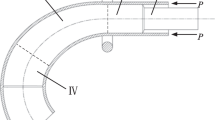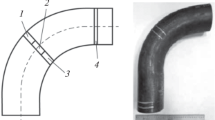Abstract
Push bending with local induction heating is a kind of advanced method fabricating large diameter and thick-walled pipe. However, geometric imperfections of the bent pipe (section flattening, excessive wall thinning at the extrados, and wall thinning even wrinkling at the intrados) have done severe damage to the safe operation of the pipeline system. In this article, a finite element model of the push bending for large diameter and thick-walled pipe with local induction heating is built and validated via experimental results first, and then the characteristics of temperature distribution and the geometric imperfections mentioned above are investigated based on the finite element model built. It is found that (1) the wall thickness fluctuates a little bit along the bending direction, and the section flattening is severest if the section position angle is between 50 and 60°; (2) the section flattening become more serious with smaller relative bending radius or narrower induction coil or lower heating temperature or faster push velocity because greater bending moment acts on the pipe under these situations; (3) relative bending radius affects the extrados wall thinning and intrados wall thickening much more than other three parameters; and (4) the intrados is probably to wrinkle if the heat temperature is too low or the induction coil is too wide or the push velocity is too fast.




























Similar content being viewed by others
Availability of data and materials
All data generated or analyzed during this study are included in this article.
References
Collie GJ, Black I (2008) An experimental evaluation of induction bending as a method of producing pipe bends with radii ≤2.5D. Proc. IMechE, Part E: J. Proc Mech Eng 222:103–114
Zhan M, Wang Y, Yang H, Long H (2016) An analytic model for tube bending springback considering different parameter variations of Ti-alloy tubes. J Mater Process Technol 236:123–137
Guo XZ, Xiong H, Li H, Xu Y, Ma ZQ, EI-Aty AA, Ma YN, Jin K (2018) Forming characteristics of tube free-bending with small bending radii based on a new spherical connection. Int J Mach Tools Manuf 133:72–84
Li H, Yang H, Zhang ZY, Li GJ, Liu N, Welo T (2014) Multiple instability-constrained tube bending limits. J Mater Process Technol 214(2):445–455
Zhou YP, Li PF, Li MZ, Wang LY, Sun S (2018) Residual stress and springback analysis for 304 stainless steel tubes in flexible-bending process. Int J Adv Manuf Technol 94:1317–1325
Zhan M, Xing L, Gao PF, Ma F (2019) An analytical springback model for bending of welded tube considering the weld characteristics. Int J Mech Sci 150:594–609
Hu Z, Li JQ (1999) Computer simulation of pipe-bending processes with small bending radius using local induction heating. J Mater Process Technol 91(1-3):75–79
Hu Z (2000) Elasto-plastic solutions for spring-back angle of pipe bending using local induction heating. J Mater Process Technol 102(1):103–108
Li XT, Wang MT, Du FSXZQ (2006) FEM simulation of large diameter pipe bending using local heating. J Iron Steel Res Int 13(5):25–29
Collie GJ, Black I (2011) An Experimental evaluation of the temperature profiles in super duplex pipe subjected to induction heating and bending. J Mater Eng Perform 20(1):90–101
Collie GJ, Higgins RJ, Black I (2010) Modelling and predicting the deformed geometry of thick-walled pipes subjected to induction bending. Proc I MechE Part L: J Materials: Design and Applications 224(4):177–189
Lee HW, Bae JH, Kim MS, Kim C (2011) Optimum design of pipe bending based on high-frequency induction heating using dynamic reverse moment. Int J Precis Eng Manuf 12(6):1051–1058
Wang X, Zhou J, Liang Q (2014) Multi-objective optimization of medium frequency induction heating process for large diameter pipe bending. Procedia Eng 81:2255–2260
Guo XZ, Jin K, Wang H, Pei WJ, Ma FY, Tao J, Kim N (2016) Numerical simulations and experiments on fabricating bend pipes by push bending with local induction-heating process. Int J Adv Manuf Technol 84(9-12):2689–2695
Kim JS, Kim KS, Oh YJ, Oh CY (2019) Proposal of residual stress mitigation in nuclear safety-related austenitic stainless steel TP304 pipe bended by local induction heating process via elastic-plastic finite element analysis. Nucl Eng Technol 51:1451–1469
Zhao LM (2007) Research in the law of influence of geometric technology parameters on axial-thrust tube bending process. Yanshan University, Dissertation (in Chinese)
Zhang YH (2008) Research on the numerical simulation of temperature field in induction heating. Dissertation, Jiangnan University
Wang Z, Deng K, Tian FX (2002) A calculation method of tube bending moment. Journal of Qingdao Institute of Architecture and Engineering 23(1):87–90 (in Chinese)
Liu HW (2010) Mechanics of materials. China University of Mining and Technology Press, Xuzhou (in Chinese)
Zhou JH (1989) Plastic deformation resistance of metal. China Machine Press, Beijing
Acknowledgements
The authors would like to thank the anonymous reviewers for their valuable comments and suggestions to improve the quality and readability of the paper.
Funding
This work was supported by the Natural Science Basic Research Plan in Shaanxi Province of China (No. 2017JM5108), the Fund of the State Key Laboratory of Solidification Processing (No. SKLSP201622), the Fund Program for the Scientific Activities of Selected Returned Overseas Professionals in Shaanxi Province (No. 2017026), and the Youth Research and Innovation Team Project of Xi’an Shiyou University (No. 2015QNKYCXTD02).
Author information
Authors and Affiliations
Contributions
Methodology: Lanyun Li and Yang Zhang; validation: Shuaishuai Xu, Lanyun Li, and Jing Liu; formal analysis: Shuaishuai Xu, Lanyun Li, and Yang Zhang; investigation: Lanyun Li, Yang Zhang, Jing Liu, and Xiaoguang Fan; writing the first draft: Lanyun Li; writing, review and editing: Lanyun Li, Yang Zhang, Jing Liu, Shuaishuai Xu, and Xiaoguang Fan; funding acquisition: Lanyun Li. All authors have read and agreed to the published version of the manuscript.
Corresponding author
Ethics declarations
Ethics approval
Not applicable.
Consent to participate
Not applicable.
Consent for publication
Not applicable.
Competing interests
The authors declare no competing interests.
Additional information
Publisher’s note
Springer Nature remains neutral with regard to jurisdictional claims in published maps and institutional affiliations.
Rights and permissions
About this article
Cite this article
Li, L., Zhang, Y., Liu, J. et al. Geometric imperfections of large diameter and thick-walled pipe fabricated by push bending with induction heating. Int J Adv Manuf Technol 114, 2003–2018 (2021). https://doi.org/10.1007/s00170-021-06905-x
Received:
Accepted:
Published:
Issue Date:
DOI: https://doi.org/10.1007/s00170-021-06905-x




